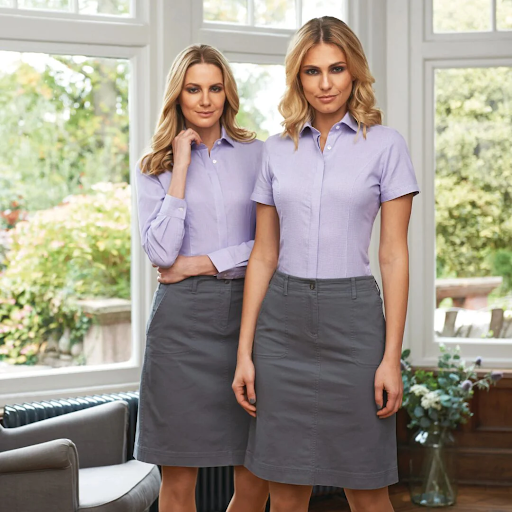
As women have taken on an increasingly visible and diverse range of roles across industries, the workwear they wear has evolved in parallel. One of the most iconic and enduring garments in women’s professional wardrobes is the workwear skirt. From the rigid, conservative uniforms of the early 20th century to today’s modern, functional styles, workwear skirts have undergone a significant transformation, both in design and in the representation they convey.
Early Days: Formality and Restriction
In the early 1900s, women’s roles in the workplace were limited, often restricted to jobs in teaching, nursing, or clerical work. Skirts were typically long, heavy, and designed for modesty rather than mobility. Social expectations of femininity and decorum significantly influenced the design of these early uniforms. While appropriate for the era, such designs were impractical for active work and often uncomfortable for long shifts.
The standard silhouette was a long A-line or pencil skirt made from wool or cotton, paired with a structured blouse or blazer. Movement was restricted, and materials were rarely chosen with comfort or utility in mind. These garments reflected societal norms more than workplace functionality.
Mid-20th Century: Practicality Begins to Emerge
As women entered the workforce in greater numbers during World War II and continued to work after the war, there was a shift toward practicality in workwear design. Skirts became slightly shorter, and fabrics evolved to include lighter, more breathable options. During the 1950s and 60s, uniform skirts were still formal, but designers began incorporating subtle functional changes, such as pleats for mobility or synthetic fibres for durability.
This era also saw the rise of the coordinated office uniform; a tailored skirt suit became standard for secretaries, bank tellers, and retail workers. However, fashion was still closely tied to rigid gender norms, and skirts remained the expected option for professional women, even when trousers would have been more practical.
Late 20th Century: Skirts Compete with Trousers
By the 1980s and 90s, the definition of women’s workwear had expanded significantly. With more women entering executive, technical, and industrial roles, trousers became a common alternative to skirts. However, this didn’t spell the end for workwear skirts. Instead, it encouraged innovation.
Designers began to experiment with more contemporary styles, fabrics, and fits. Stretch materials, machine-washable fabrics, and breathable blends became standard. Pencil skirts remained popular, but A-line and wrap styles gained traction due to their added comfort and versatility. Skirts were no longer seen solely as a symbol of traditional femininity—they were becoming tools of empowerment, adapted to meet the needs of modern women in dynamic workplaces.
21st Century: Skirts as a Statement of Style and Function
Today’s workwear skirts are built with flexibility, inclusivity, and personal expression in mind. With workplaces embracing a wider variety of dress codes, from formal corporate environments to smart-casual or creative studios, skirts are designed to offer both style and function. Skirts now incorporate features such as hidden pockets, moisture-wicking linings, wrinkle-resistant materials, and adjustable waistbands.
Many brands are also aligning with sustainable fashion principles, producing skirts from eco-friendly materials without sacrificing durability or performance. Importantly, modern workwear brands now offer a wide range of sizes and fits to ensure comfort and confidence for all body types.
The design shift has also blurred the lines between casual and professional attire. A well-constructed workwear skirt can easily transition from boardroom to after-hours events, providing flexibility for women who need their wardrobe to perform in multiple settings throughout the day.
The Rise of Versatile Options: From Skirts to Dresses
As the definition of women’s workwear has broadened, so has the range of garments available. In addition to skirts, many women are turning to women's workwear dresses for a simple, stylish solution to professional dressing. Dresses offer the ease of a one-piece garment with the polish of coordinated separates, often incorporating many of the same practical features found in modern skirts.
Whether it's a sheath dress for a corporate office, a wrap dress for hospitality roles, or a utility dress for creative fields, today's women's workwear dresses are as functional as they are fashionable. Together with skirts, they provide versatile options that reflect the diverse roles and needs of today’s working women.
Conclusion: The Modern Role of Workwear Skirts
The evolution of workwear skirts reflects broader societal shifts, changes in gender roles, and evolving workplace culture. From restrictive, formality-driven garments to today’s adaptable and stylish pieces, skirts have remained a core component of women’s professional wardrobes—but on vastly different terms. Today’s skirts are not only compliant with workplace standards but also empowering, offering comfort, functionality, and a sense of self-expression.
As the market continues to grow and evolve, it’s clear that women are no longer forced to choose between practicality and style. For those looking to expand their wardrobe with flexible, professional garments, women’s workwear dresses are also becoming an equally important and empowering option, complementing the evolution of the modern workwear skirt.
















